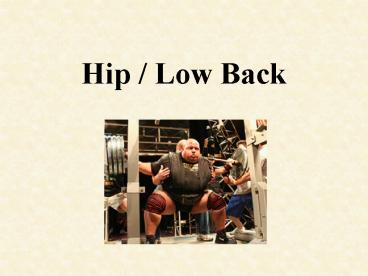Hip / Low Back PowerPoint PPT Presentation
1 / 21
Title: Hip / Low Back
1
Hip / Low Back
2
Hip Anatomy - Bones
3
Hip Anatomy - Ligaments
4
Hip Anatomy - Muscles
- Abductors
- Gluteus medius
- Gluteus maximus
- Gluteus minimus
- Sartorius
- Tensor Fasciae Latae
- Adductors
- Adductor brevis
- Adductor longus
- Adductor magnus
- Gracilis
- Pectineus
- Gluteus maximus
5
Hip Anatomy - Muscles
- Flexors
- Gluteus medius
- Gluteus minimus
- Iliacus
- Psoas major minor
- Rectus Femoris
- Sartorius
- Tensor Fasciae Latae
- Extensors
- Biceps Femoris
- Gluteus maximus
- Gluteus medius
- Semimembranosus
- Semitendinosus
6
Hip Anatomy - Muscles
- Internal Rotators
- Adductor brevis
- Adductor longus
- Adductor magnus
- Gluteus medius
- Gluteus minimus
- Semimembranosus
- Semitendinosus
- Tensor Fasciae Latae
- External Rotators
- Biceps femoris
- Gemellus inferior superior
- Gluteus maximus
- Gluteus medius
- Obturator externus internus
- Piriformis
- Quadratus Femoris
- Sartorius
7
Hip Injuries
- Piriformis Syndrome
- Spasm of hypertrophy of the piriformis muscle
placing pressure on the sciatic nerve - MOI Blow to the buttock, hyperinternal rotation
of femur
8
Hip Injuries
- Iliac Crest Contusion (Hip Pointer)
- MOI Direct blow to an unprotected ilium
9
Hip Injuries
- Hip Dislocation
- Most hip dislocations occur when the hip is
flexed and adducted with an axial force to the
femur, displacing it posteriorly and causing the
femoral head to be driven through the posterior
capsule
10
Low Back Pain Statistics
- One-half of all working Americans admit to having
back pain symptoms each year - Back pain is one of the most common reasons for
missed work. In fact, back pain is the second
most common reason for visits to the doctors
office, outnumbered only by upper-respiratory
infections. - Most cases of back pain are mechanical or
non-organicmeaning they are not caused by
serious conditions, such as inflammatory
arthritis infection, fracture or cancer. - Americans spend at least 50 billion each year on
back painand thats just for the more easily
identified costs. - Experts estimate that as many as 80 of the
population will experience a back problem at some
time in our lives - (American Chiropractic Association)
11
Low Back (Lumbar) Anatomy - Bones
12
Lumbar Anatomy - Ligaments
13
Lumbar Anatomy - Muscles
- Rotation
- Multifidis
- Flexion
- Rectus Abdominis
- External Oblique
- Internal Oblique
- Extension
- Iliocostalis
- Spinalis
- Longissimus
- Lateral Bending
- Internal Oblique
- External Oblique
14
Lordosis
15
Lumbar Injuries - Sciatica
- Inflammation of the sciatic nerve.
- Causes of sciatica
- Disc herniation
- Sacroiliac joint dysfunction
- Scar tissue formation around the nerve root
- Nerve root inflammation
- Spinal stenosis
- Synovial cysts
- Cancerous or non-cancerous tumors
16
Lumbar Injuries Disc Herniation
They are often the result of repetitive motion
(truck drivers/machine users) or due to a sudden
heavy loading of the back (improper lifting)
17
Lumbar Injuries Spondylolysis and
Spondylolisthesis
- MOI Pars interarticularis suffers a stress
fracture secondary to repetitive stress from
spinal extension
18
Lumbar Injuries Spinal Stenosis
- A narrowing of the vertebral foramen where the
nerve root or spinal cord pass - Causes thickened ligaments along the spinal
canal, bony spurs, and enlarged joint cartilage
from arthritic changes
19
Lumbar Injury Prevention
- Technique
- Proper breathing techniques
- Core Strength
- Maintain a healthy diet and weight.
- Remain active
- Avoid prolonged inactivity or bed rest.
- Warm up or stretch before exercising or other
physical activities. - Maintain proper posture.
- Wear comfortable, low-heeled shoes.
- Sleep on a mattress of medium firmness to
minimize any curve in your spine. - Lift with your knees, keep the object close to
your body, and do not twist when lifting. - Quit smoking. Smoking impairs blood flow,
resulting in oxygen and nutrient deprivation to
spinal tissues - (American Chiropractic Association)
20
Core Strengthening
21
Question / Comments?

